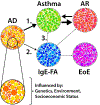One march, many paths: Insights into allergic march trajectories
- PMID: 33971364
- PMCID: PMC8418995
- DOI: 10.1016/j.anai.2021.04.036
One march, many paths: Insights into allergic march trajectories
Abstract
Objective: The classical allergic march model posits that atopy begins in infancy with atopic dermatitis and progresses to asthma and allergic rhinitis in a subset of individuals. The growing prevalence and severity of allergic diseases have prompted renewed interest in refining this model. This review outlines epidemiologic evidence for the existence of allergic march trajectories (distinct paths of atopy development in individuals); reviews the roles that genetics, environment, and disease endotypes play in determining trajectory outcomes; and discusses the clinical utility of the trajectory model.
Data sources: PubMed search of English-language articles and reviews without date limits pertaining to the epidemiology, genetics, and immunologic mechanisms of allergic march trajectories and disease endotypes.
Study selections: Studies and reviews were selected based on their high quality and direct relevance to the review topic.
Results: Recent work in the field has revealed that immunoglobulin E-mediated food allergy and eosinophilic esophagitis are components of the allergic march. Furthermore, the field is acknowledging that variability exists in the number and sequence of allergic manifestations that individuals develop. These allergic march pathways, or trajectories, are influenced by genetic, environmental, and psychosocial factors that are incompletely understood.
Conclusion: Continued elucidation of the landscape and origins of allergic march trajectories will inform efforts to personalize allergic disease prevention, diagnosis, and treatment.
Copyright © 2021 American College of Allergy, Asthma & Immunology. Published by Elsevier Inc. All rights reserved.
Conflict of interest statement
Figures


References
-
- Hill DA, et al. “A march by any other name.” Annals of Allergy, Asthma and Immunology 121.1 (2018): 137–138. - PubMed
-
- Busse WW. “The atopic march: fact or folklore?.” Annals of Allergy, Asthma and Immunology 120.2 (2018): 116–118. - PubMed
-
- Paller AS, et al. “The atopic march and atopic multimorbidity: Many trajectories, many pathways.” Journal of Allergy and Clinical Immunology 143.1 (2019): 46–55. - PubMed
Publication types
MeSH terms
Grants and funding
LinkOut - more resources
Full Text Sources
Other Literature Sources
Medical

